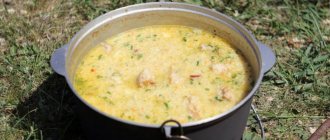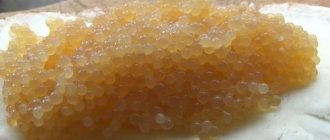An accessible source of food for the traveler are snails. Almost all of their species found in the territory of the former USSR are edible. They are often found in large colonies, therefore, without any serious effort, literally with your bare hands in a few minutes you can collect and cook a significant number of land mollusks, among which the grape snail occupies a special place.
General information about grape snails
The grape snail is a terrestrial gastropod, one of the largest representatives of the stalked-eyed order living in Russia (Figure 1).
Due to its size, this species is of gastronomic interest.
The habitat on our continent includes Central and Eastern Europe, Western Asia.
Figure 1. Grape snail
The body is asymmetrical, with a noticeably prominent head and a wide, flat leg. At the top of the head there are two pairs of tentacles, and on the long tentacles there are a pair of eyes. Breathing is pulmonary. The round shell is twisted spirally, forming 4.5 turns. The color of the shell is light brown, often with dark stripes. With age it becomes whitish. When the shell is damaged, a protein-mineral secretion is immediately released, which quickly hardens in air and firmly cements the crack. After a couple of weeks, its integrity is completely restored. The mobile and elastic body usually has a beige-brown color scheme. The average shell weight of an adult is 5-7 g, the average body weight is 25-35 g, sometimes reaching 50 g.
Their benefits
Like oysters, grape snails are considered a very healthy product and a source of high-quality protein.
Fresh snail meat contains:
- 10-17% proteins;
- 20-30% fat;
- 5-12% carbohydrates;
- vitamins and mineral elements: B vitamins, iron, calcium, magnesium, etc.
Figure 3. These are the dishes that can be prepared from grape snails, which also affects the nutrient content of the final product.
Specific numbers depend on the variety and food they eat, as well as on the method of their preparation (Figure 3).
In dried form, the percentage of protein increases significantly: up to 60-65%, and fat decreases to 5%.
Thus, snail meat is a nutritious and easily digestible product.
Product benefits
Are grape snails healthy? The method of preparing this product is such that it retains almost all the nutritional components. It should be noted that snail meat is often recommended for those who are on a diet. After all, 100 g of this product contains only 90 calories, as well as 2-3% fat, 15% protein and no cholesterol. In addition, snails contain unsaturated fatty acids. They are rich in phosphorus, zinc, magnesium, calcium, potassium, copper, iron and vitamins B, A and E.
Cooking snails in boiling water
One of the simplest preparation options available in the field is boiling (Figure 4). You will need to boil water in a suitable container and place the gastropods in it for 5-10 minutes. In principle, most of the parasites will already die, and the snails after such treatment are quite suitable for food.
Figure 4. Boiling is one of the simplest ways to prepare snails
If you have time and some vegetables, it is better to carry out additional manipulations that will improve the taste of the dish. The body must be removed from the shell, and the fleshiest part, the leg, must be separated from the insides. From a dozen of these legs you can make snail kebab or soup.
Cleaning grape snails at home
Despite the fact that in many countries around the world snails are part of the usual human diet, in Russia they are rarely perceived as a complete product. The preparation of land shellfish in our country is determined by the desire to try unusual tastes, or to impress guests and household members.
Accordingly, the requirements for the preliminary preparation of a product for an exotic menu are the highest - few people prepare food using extreme technologies at home.
Figure 5. Cleaning grape snails is an important process that affects the taste of the prepared dish.
And preparation begins with traditional product cleaning:
- Live snails are placed in an empty pan, covered with a lid to prevent them from spreading, and left to fast for a period of 3 days to 2 weeks. Once every 1-2 days it is necessary to moisten the dishes and wash the captives. Sometimes they are not put on a strict hunger strike, but a couple of tablespoons of wheat flour and aromatic herbs are left as food. During such a fast, the body of the gastropod has time to cleanse itself from the inside.
- The next step is to get rid of the characteristic mucus. To do this, live snails are placed on a layer of rock salt for a couple of hours. Contact with an aggressive environment causes them to secrete mucus in large quantities (Figure 5).
- The shellfish are washed, the dead ones are discarded, and the remaining ones are boiled in boiling water for 3-5 minutes.
- Boiled snails should be thoroughly washed to remove any coagulated mucus, removed from their shells, and the internal organs separated from the body.
- It is correct not only to cook the resulting fillet immediately, but also to freeze it for future use, which will avoid days-long preliminary preparation of each culinary masterpiece.
- Shells, if you intend to use them for serving, should be boiled in a soda solution (2 tablespoons per liter of liquid), rinsed well and dried.
Snails - primary processing, cooking technology
by the author
Snails - primary processing, cooking technology.
Snail is a terrestrial gastropod.
Snail meat contains up to 10% easily digestible protein, which is several times higher than that of a chicken egg, about 30% fat and 5% carbohydrates. B vitamins, macro and microelements.
Use of snails in cooking:
The season for catching snails, from which the most delicious dishes are obtained, begins from the beginning of April until the beginning of October.
In many cuisines around the world, snail is considered a gastronomic delicacy. The appearance of snails in cooking dates back to ancient Greece; snails were fried and eaten before dinner, washed down with wine. In the Middle Ages, snails were considered a lean food and were eaten fried with onions during fasting.
Nowadays, snail is present in the cuisines of many countries:
In France, Germany, Switzerland and a number of other countries, the main supplier of snails is Greece. In the cuisines of these and many other countries, there are a large number of recipes for preparing dishes with snails. Thousands of tons of snails are eaten in these countries every year.
In addition to importing snails, Russia has its own supplier in the Kaliningrad region. There, snails are bred for sale to restaurants, for use in the pharmaceutical industry, and for sale in stores.
Primary preparation and processing:
1 - The first thing you need to do after you bring fresh snails home is to make sure that all the snails are alive. To do this, place the snails in a large container of water. After some time, live snails will emerge from their shells. We sort the snails and wash the live ones in running water.
2 – Next, you need to put the snails in a saucepan with a lid and add a little flour. So the snails must be kept for 24 hours by periodically sprinkling them with water. During this time, the snails are cleansed of unwanted, unpleasant reserves. You can optionally increase the period to three days. At the same time, on the second day we reduce the amount of flour by half. On the third day we don’t give anything.
3 – Then we transfer the snails into a container with strongly salted water and leave for 2 hours so that the snails release their mucus.
4 –Next, rinse well, periodically changing the water, and use a brush.
5 - Next, remove the film from the snails that covers the hole and put the snails in acidified water, which we heat a little over low heat. The snails themselves begin to crawl out of their shells; those that do not crawl out are very easily removed with a toothpick.
In cooking we use only the fleshy part of the snail (leg).
After you have removed the snail meat, you are left with empty shells; they are also used in cooking; they can be used for serving in some dishes. But for this, the shells also need to be prepared. The shells must be boiled in water with the addition of soda for an hour. Then rinse in clean water and dry. This treatment allows the shells to be reused many times.
Cooking technology:
Before eating snail meat, it must be boiled in salted water with spices for twenty minutes. Be careful not to overcook the snails, otherwise the meat will become tough and tasteless.
Snails can be prepared in different ways, and there are hundreds of dishes with snail meat: cook broths; stew with wine; grill on a grill, sprinkle with salt, pepper and fennel; stuffed and baked.
READ ALSO: Candied ginger benefits and harm
watch the video
Snails in Chinese cuisine are cooked together with chicken or other various seafood, usually supplemented with vegetables. As for Japanese cuisine, here snail meat is consumed raw, after being thinly sliced and marinated in vinegar.
Snails are becoming increasingly popular in the cuisines of different countries. From the point of view of nutritionists, snails are simply an invaluable dietary product; per hundred grams of snail meat there are only 50 kcal and zero cholesterol.
Chilled dry and semi-dry white wines are perfect accompaniments for snail dishes.
In the article we looked at the primary processing of snails and some aspects of the preparation technology. If you liked the article or found it useful, leave your comments.
See you soon.
Cooking grape snails: process
In addition to making snail fillets yourself, you can purchase a ready-made semi-finished product in the store (Figure 6). Blanched snails are a popular ready-made dish and are also often sold frozen.
Figure 6. You may not have paid attention, but there is quite a wide range of semi-finished snail products on the shelves.
Once you have prepared gastropods for cooking, further variations in their processing differ little from many other products. Grape snails are boiled, stewed, marinated using vinegar or lemon juice. Many recipes involve adding dry wine, if not during the cooking process, then at least when serving.
Cooking process
How are grape snails stewed? The recipe for this dish requires the use of a saucepan. Olive oil is poured into it, and then previously processed snails are laid out. After frying the product a little (right in the shells), it is poured with dry red wine, and then salted, peppered and simmered over low heat for about ¼ hour.
Shortly before turning off the stove, add finely chopped herbs to the saucepan and mix all the ingredients thoroughly.
It is advisable to serve the finished snails in their shells hot, after pouring them with the sauce remaining in the saucepan.
Snail delicacy recipes
Grape snails are not only an extreme food; you can use them at home to prepare a very tasty dish or even several dishes that will be the envy of many restaurants. If you are not a fan of frozen convenience foods, try one of the following recipes.
Classic recipe: Burgundy snails
This is one of the traditional dishes of French cuisine. There are many options for its implementation, starting from the ingredients used. Nowadays, there are cooking methods using special utensils - an escargot dish or in small baking dishes, however, in its classic form, the “Burgundy” recipe is prepared directly in the shells of the mollusks themselves (Figure 7).
Figure 7. The French are not only fond of frogs; Burgundian snails are also respected in this country 
To prepare you will need:
- Grape snails – 50 pcs.
- Garlic – 15 g.
- Shallots, stems – 15-17 g.
- Parsley leaves – 20 g.
- Butter – 200 g.
- Ground black pepper.
- Salt.
Step-by-step preparation:
- Boil the snails in clean water for 5 minutes, then let them cool.
- Remove clams from shells and separate back.
- Cook the resulting snail fillet separately for 30 minutes.
- Boil the shells in a soda solution (2 tablespoons/liter), dry.
- Next, prepare the filling: grind garlic, onion, parsley in a blender. Add salt and pepper according to your preferences.
- Add softened butter to the resulting mixture and mix again until a uniform consistency is obtained.
- Place a little prepared garlic-oil mixture into the processed shells, place the shellfish meat there, and tightly cover with another portion of the oil mixture.
- Place the filled shells in an escargot bowl or on a baking sheet sprinkled with a layer of salt (the task is to securely place them with the holes facing up), bake in an oven preheated to 200 degrees for 7 minutes.
Serve well directly in the escargot bowl, or simply on a plate. One standard serving consists of 6 filled shells. They are properly eaten in this form using a two-pronged fork and large tongs to hold the shell.
Tender clam soup
The meat of gastropods is used for cooking and first courses. Here is one of the possible recipes (Figure 
Figure 8. Tender soup with snails
.
To implement it you will need:
- Snail fillet – 25 pcs.
- Medium-sized onions – 4 pcs.
- Butter – 40 g.
- White wine – 200 ml.
- Cream – 200 ml.
- Meat broth – 1 l.
- Carrots – 25 g.
- Celery root – 25 g.
- Leek – 25 g.
- Egg yolk – 2 pcs.
- Parsley – 30 g.
To prepare, first of all, you need to prepare:
- cut carrots and celery into strips;
- Mix the yolks and cream together.
Cut the onion into small cubes and place in a saucepan. Add half of the crushed grape snails, butter and simmer for 15 minutes. Pour meat broth and wine into a saucepan and bring to a boil. If you are using broth without adding salt, add salt to the dish at this stage. After boiling, add the remaining chopped snail fillet and chopped vegetables and simmer for another 10 minutes. Immediately after turning off, pour the mixture of yolks and cream into the resulting dish and stir.
Before serving, sprinkle with chopped herbs.
Snails in tomato sauce: exotic taste
In many countries, snail meat is a common ingredient in a variety of dishes. However, there are cooking methods that are exotic for connoisseurs. Let's try one of them (Figure 9).
Figure 9. Cooking another interesting dish: snails in tomato sauce
First of all, you should stock up on products:
- Snail fillet – 25 pcs.;
- Medium size onion – 1 pc.;
- Vegetable oil – ¼ cup;
- Tomato paste – 2 teaspoons.
- Bell pepper – 1 pc.
- Spices;
- Salt;
Preparation:
Place gastropods in a saucepan, add water so that they are completely hidden under the surface. Add salt and cook for about 10 minutes, then drain the liquid.
Cut the onion into half rings and sauté in oil for 1-2 minutes. Then add tomato paste, salt, spices to the pan and simmer for another 2 minutes. Finally, add the boiled fillet to the frying pan and cook for another 5 minutes.
Thread the finished shellfish with onion half rings onto skewers (toothpicks) like a kebab, alternating with pieces of bell pepper.










